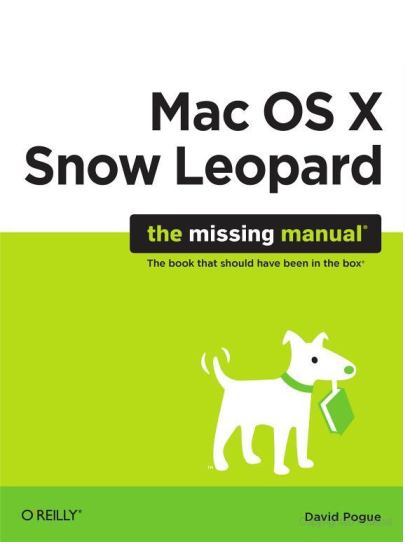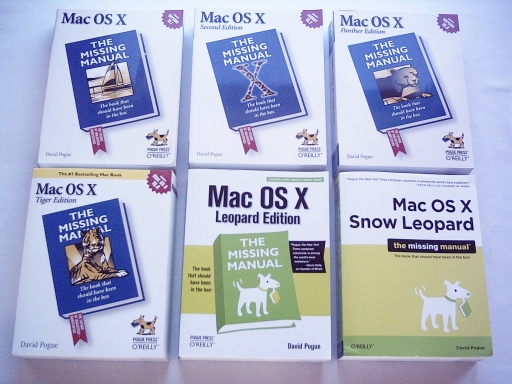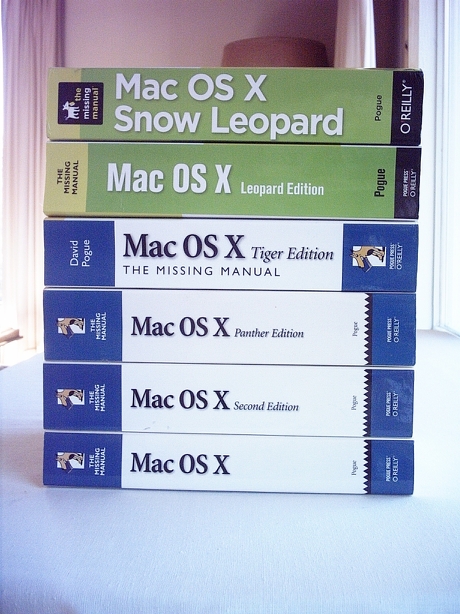‘Book Mystique Review: Mac OS X Snow Leopard: The Missing Manual
Wednesday, November 18, 2009
by Charles W. Moore
The latest edition of David Pogue’s Mac OS X: The Missing Manual is without question the most anticipated Mac book of any year when there’s a new Mac OS version release. My favorite Mac OS X book (and evidently most everybody else’s as well since it’s been the the bestselling computer book in America since 2007) is back in a new revised edition of the “Missing Manuals” series flagship -- “Mac OS X Snow Leopard: The Missing Manual” The sixth edition has a tough act to follow. Will OS X Snow Leopard TMM be able to sustain bestseller performance? Given the robust sales of the Mac OS 10.6 Snow Leopard upgrade, I’m inclined to think that it will.
But isn’t OS X 10.6 Snow Leopard essentially just an Intel-optimized and slimmed-down update of OS X. 10.5 Leopard? Well, no. Despite Steve Jobs disclaimer that “With version 10.6 we are hitting Pause on new features” with this version of the operating system, OS X TMM author David Pogue says “not everyone got the memo. An insane amount has changed -- tiny, tweaking things, under-the-hood things, and even some big routine-changing things.” Pogue says that consequently, instead of a light and easy revision of TMM, bringing the manual up to date with Snow Leopard changes was “absolutely exhausting, but I guess somebody’s got to do it.”
Delighted you feel that way, David! I certainly wouldn’t want to be without a current version of OS X TMM, which I continue to maintain is the OS X book to have if you’re only having one.

It’s not the cheapest book to add to your reference library, at $34.99, which holds the price line for US readers. We Canucks ask get a stiff price hike from Canadian $34.99 on the Leopard edition to Canadian $43.99 for this latest version, which is even more than the $41.95 we paid for the Tiger edition. Unfortunate timing for us, since the October, 2009 publication date fell just short of the Canadian dollar’s current runup toward parity with the greenback again, but we can at least console ourselves that the Apple is only dinging us $34.99 for the Snow Leopard OS upgrade itself
As usual with David Pogue books, this latest OS X TMM iteration is a fun and entertaining read as well as being highly informative and helpful, striking just the right balance between attention to detail, and easy, pleasant readability. But don’t infer that the author doesn’t address his subject thoroughly. Pogue gives us his take on which Snow Leopard features work well and ones not so much, what should upgraders be looking out for, and what should perhaps be avoided. New content in this edition includes:
Everything new: the rewritten Finder, 64-bit mode, Microsoft Exchange compatibility, Build-them-yourself Services and keyboard shortcuts, self-waking network Macs, and more
The Dock, the MacOS X folder structure and Mail: all faster and with new Snow Leopard-only features
Safari 4: the latest and best-performing Apple Web browser
QuickTime X: the new multimedia player that lets you trim and share clips to YouTube, MobileMe, and ITunes. QuickTime Player is also new. The new player can even make audio recording, video recordings, and -- a first for a mainstream operating system -- even screen recordings, so you can create how-to videos for your less-gifted relatives and friends.
New text editing features: Mac OS X’s systemwide spelling and grammar checker is joined this time around by a typing-expansion feature. You can create your own abbreviations that when typed, expend to a word, phrase, or even a blurb of canned text many paragraphs long. It’s great for auto fixing typos, of course, but also for answering the same questions by email over and over.
Services are reborn: Services, the little menu of miscellaneous commands that has been in the application menu for years, now has been refreshed and revised for Snow Leopard. They now appear only when they’ll actually do something. Better yet, creating your own system-wide services commands is a piece of cake, as Chapter 7 makes clear. You can also assign any keystroke you like to them. The
A cool collection of tips, tricks, and undocumented shortcuts: This book demystifies the hundreds of smaller enhancements to all 50 programs that come with the Mac: including Safari, Mail, iChat, Preview, Time Machine, and so forth
Power usage: Security, networking, build-your-own Services, file sharing with Windows, even MacOS X’s UNIX chassis
A few of the big-ticket item changes include:
It’s faster. Not everything is faster, but wherever Apple put effort into speeding things up, you will feel it. The Finder and the Desktop are rewritten from scratch. Startup and shutdown are faster, Mail and Safari open faster. Time Machine backups are faster and installation is faster (and many steps simpler).
It’s better organized. Features like Exposé and Stacks (pop-up Dock folders) have been redesigned to make sense and reduce scrolling.
It talks to Exchange corporate computers. Just by entering your name and password for your company’s network, you make your Mac part of the Microsoft Exchange system. That is, your corporate email shows up in MacOS X’s Mail program, the corporate directory shows up in Address Book, and your company calendar shows up in iCal -- right alongside your own personal mail, addresses, and appointments.
It’s better for laptops. The Mac automatically adjusts the zone clock when you travel just like a cell phone. The menu of nearby wireless hotspots now shows the signal strength for each. Three and four finger trackpad “gestures” now work on even the oldest Multi-Touch Mac laptops.
Some smaller things:
The menubar can know now show the date, and not just the day of the week.
When you’re running Windows on your Mac, you can now open the files on the Macintosh “side” without having to restart.
Icons can now be 512 pixels square, which is pretty huge, and can turn any desktop window into a light table for photos.
There’s now a Put Back command in the Trash, which flings the discarded I am back into the folder it came from, even weeks later.
You can page through a PDF document or watch a movie right in a file’s icon.
Buggy plug-ins no longer crash Safari; you just get an empty rectangle where they would’ve appeared.
Video chats in iChat have much smaller connection-speed requirements.
As with the previous additions, Mac OS X Snow Leopard TMM is organized into six parts.
Part One, The MacOS X Desktop, covers everything you see on the screen when you turn on any Mac OSx computer: the Dock, the sidebar, Spotlight, Dashboard, Spaces, Exposé, Time Machine, icons, windows, menus, scrollbars, the trash, aliases, the Apple Menu, and so forth.
Part Two, Programs In Mac OS X, is dedicated to the proposition that an operating system is little more than a launch pad for programs, the actual applications you use in your everyday work, such as email clients, Web browsers, word processors, graphics editing programs, and so forth. These chapters describe how to work with applications in MacOS X: how to launch them, switch among them, swap data between them, use them to create and open files, and control them using the AppleScript and Automator automation tools.
Part Three, The Components Of MacOS X, is an item-by-item discussion of the individual software nuggets that make up this operating system-— the 27 panels of system preferences, and the 50 programs in your applications and utilities folders.
Part Four, The Technologies Of MacOS X, goes into more advanced territory, networking, file sharing, and screen sharing are, of course, tasks Mac OS X excels at. These chapters cover all of the above, plus the prodigious visual talents of MacOS X. (fonts, printing, graphics, handwriting recognition), its multimedia gifts (sound, speech, movies), and the robust UNIX architecture that lies under the proverbial hood.
Part Five, Mac OS X Online, covers all of the Internet features of MacOS X, including the Mail email program and the Safari Web browser/RSS reader; iChat for instant messaging and audio or video chats; Web sharing; Internet sharing; and Apple’s online MobileMe services (which include email accounts, secure file-backup features, Web hosting, and more). If you’re feeling particularly advanced, you’ll also find instructions on using Mac OS X’s UNIX underpinnings for connecting to, and controlling, your Mac from across the wires-— FTP, SSH, VPN, and so on.
Part six, Appendices, includes a Windows-two-Mac dictionary (to help Windows refugees find the new locations of familiar features in Mac OS X); guidance in installing this operating system; a troubleshooting handbook; a list of resources for further study, and an extremely thorough master list of all the keyboard shortcuts in Mac OS X Snow Leopard.
There is also a 24-page Index.
Obviously there is little ground that David Pogue hasn’t covered in this volume. That’s what’s great about Mac OS X: The Missing Manual (any edition) — aside from the good writing, is its comprehensiveness. Whatever aspect of working with the operating system and the dozens of programs that come bundled with it, you’re almost certain to find it addressed in the pages of this book - all packaged to accommodate the needs and computer skill levels of Mac users from first-time newbies to power users, an objective that has happily been accomplished without descending into dumbed-down blandness. Instead, the primary text is written at a technical level ranging from an advanced beginner to intermediate, which covers the preponderance of the Mac-using community, and which should prove neither totally inaccessible to rank amateurs, nor boringly tedious for the power user cohort. However, the specific needs and interests of the latter two categories are addressed with sidebars that appear frequently entitled “Up To Speed” and “Power Users’ Clinic” respectively, and which have been expanded in this edition.
As with previous editions of Mac OS X TMM, inside the back cover is a graphic of the Missing CD-ROM that doesn’t come with this book, thus saving you $5.00. Instead you can go to http://missingmanuals.com and voila! - there: are contents of what would have been on the CD if there were one there for you to download. See the Appendix below for a list of the Missing CD contents.

Mac OS X The Missing Manual has grown substantially over the years, with the original OS X. 10.1 edition having hit its thickest with the OS 10.5 Leopard Edition at just shy of a Tolstoyesque 900 pages., up from the Tiger Edition’s already hefty 849 pages. Indeed, Mac OS X: The Missing Manual, had grown steadily with each successive release, the OS 10.3 Panther, OS 10.2 Jaguar, and OS 10.1 editions weighing in at 763, 713, and 583 pages respectively.

A word about version updates. Two weeks after the public release of MacOS X 10.6, Apple posted a free update to version 10.6.1, and if past history is a guide, there could eventually be up to 11, or even more of these version updates eventually. These incremental updates patch holes, fix bugs, improve compatibility with peripherals, and generally refine the operation of the system.
Version 10.6.1, for example, included a long inventory of bug fixes and compatibility with cellular modems, DVD playback, printer compatibility, automatic login bugs, glitches in Mail, and more. This book covers up to version 10.61, but subsequent to its publication two months ago OS 10.6.2 is already out, with presumably 10.6.3 on the way, and so it goes. However, none of these updates are likely to render this book significantly out of date, as historically the “first decimal point” updates don’t change anything fundamental features-wise, and as mentioned are pretty much about refinement and bug fixing.
Was there anything I disliked about Mac OS X Leopard: The Missing Manual? Not really. I love this book! Pogue Press/O’Reilly claims that Mac OS X TMM is the most authoritative book for Mac users of all technical levels and experience, and they’re not just blowing PR smoke. Anyway, if you have upgraded to OS X 10.5 Leopard or are contemplating doing so, and wondering if you should also upgrade your copy of OS X: TMM to the fifth edition, the answer is “of course.” The new Leopard features are reason enough. For the vast majority of OS X users, it’s really tough to beat OS X: The Missing Manual for its eponymous purpose. It really is “the book that should have been in the box.”
“Mac OS X Snow Leopard: The Missing Manual” is, like its predecessors, an amusing and fun to read a must-have reference.
Mac OS X Snow Leopard: The Missing Manual
http://oreilly.com/catalog/9780596153298
David Pogue
ISBN 13: 9780596153281
912 pages
$34.99 USD, 30.99 GBP
order@oreilly.com
1-800-998-9938
1-707-827-7000
Note: Letters to PowerBook Mystique Mailbag may or may not be published at the editor's discretion. Correspondents' email addresses will NOT be published unless the correspondent specifically requests publication. Letters may be edited for length and/or context.
Opinions expressed in postings to PowerBook Mystique MailBag are owned by the respective correspondents and not necessarily shared or endorsed by the Editor and/or PowerBook Central management.
If you would prefer that your message not appear in PowerBook Mystique Mailbag, we would still like to hear from you. Just clearly mark your message "NOT FOR PUBLICATION," and it will not be published.
CM